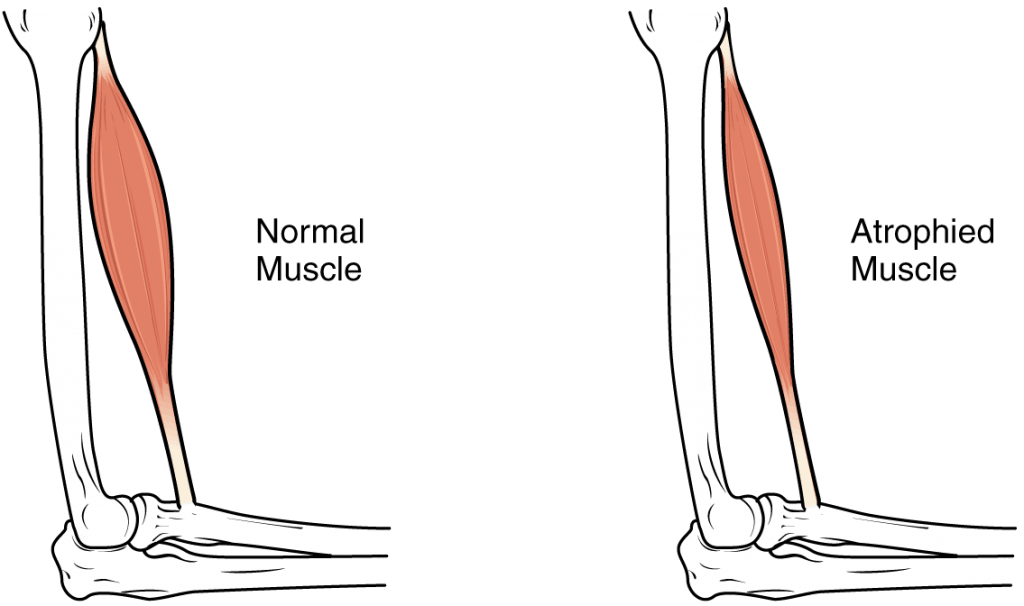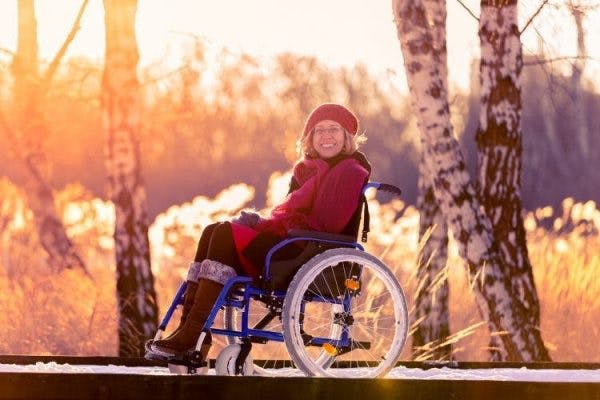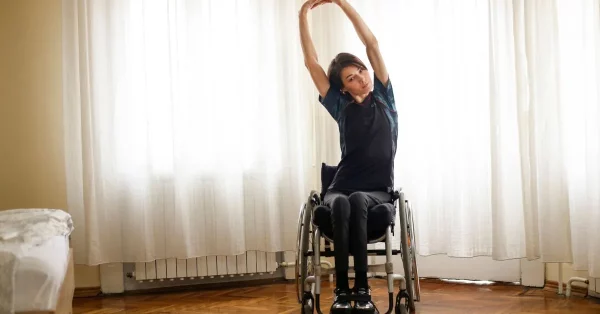A T6 spinal cord injury can affect motor control and sensation from the top of the abdomen down.
Luckily, T6 spinal cord injury patients usually have normal upper extremity functions; therefore, control of the head, neck, shoulders, arms, hands, and chest are often unaffected.
This article will help guide you through the potential effects of T6 spinal cord injury and how to approach recovery.
What to Expect After a T6 Spinal Cord Injury
Before we get started, it’s essential to understand that every T6 spinal cord injury is unique.
Depending on how severe the SCI is, individuals can experience a wide variety of different secondary effects.
Generally, functions above your level of injury will not be affected. However, depending on how many spared neural pathways you have at the T6 level of injury, the functions affected below your level of injury will vary.
In the following sections, we’ll go over 7 potential secondary effects that can occur after a T6 SCI.
1) Walking Impairments

Walking impairments are one of the most prevalent effects of T6 spinal cord injury.
Depending on the severity of the injury, T6 SCI patients can experience gait abnormalities ranging anywhere from a slowed pace to the inability to walk at all.
As a result, T6 SCI patients may need to use a wheelchair, crutches, or a walker for mobility support.
2) Poor Sitting Balance
Because a T6 spinal cord injury can affect the core muscles, individuals may struggle to sit upright.
Even leaning over a little bit can cause an SCI patient to lose balance and fall over. This is important to remember when trying to reach for objects (especially if using both hands), as stretching too far could cause the individual to fall from their chair.
Luckily, individuals with T6 spinal cord injuries typically have normal functioning of their hands and arms. As a result, they can generally use their upper extremities to hold their bodies upright and compensate for lack of core strength.
3) Loss of Bowel and Bladder Control
Many T6 spinal cord injury patients lose control over their bowel and bladder muscles.
If they experience loss of sensation in those muscles, they may be unable to tell when they need to use the bathroom and become prone to accidents.
Additionally, loss of motor control over the bladder muscles can cause urinary retention. When the bladder gets too full, urine can get stuck in or backed up to the kidneys and cause serious damage.
Similarly, loss of sphincter control can lead to constipation, abdominal bloating, and discomfort.
Regular use of a catheter and participation in a bowel program can decrease the likelihood of complications from lack of control over these muscles.
4) Muscle Atrophy in the Legs
T6 spinal cord injury patients are susceptible to lower extremity muscle atrophy, which is the loss of muscle density in the legs.
Muscle atrophy is caused by reduced physical activity.
Impaired leg functions often prevent SCI patients from moving as much as they used to. As a result, their bone and muscle mass decrease, which increases the risk of falls and fractures. Think ‘use it or lose it.’
5) Involuntary Leg Contractions
Another common outcome of T6 spinal cord injuries is involuntary leg contractions (spasticity).
Even when the individual cannot move their legs at all, they can still experience spasticity in the form of leg spasms or prolonged muscle tightness.
Believe it or not, leg spasms are a good sign of spinal cord injury recovery.
They indicate that neural connections between the brain and areas of the body below the level of injury still exist.
Generally, leg spasms occur because the sensory nerves become extremely sensitive to stimuli and trigger a spastic reflex.
Through physical therapy, SCI patients can consistently stimulate that nerve, which often helps reduce its hypersensitivity. Stretching regularly and bearing weight through the legs can often help with spasticity.
6) Pressure Sores in the Hips, Knees, or Ankles
T6 spinal cord injury patients may also develop pressure sores, which are caused by sitting or lying in the same position for prolonged periods.
This occurs because SCI patients with impaired sensation often don’t feel the need to move when staying in the same position for too long.
As a result, pressure on an area of skin accumulates over time and cuts off blood flow, resulting in tissue death. The skin gradually breaks down, creating an open sore that may even reach the bone.
Pressure sores are most common in areas of the body where bone and skin are closely aligned, which is why T6 spinal cord injury patients will often develop pressure sores at the hips, knees, and ankles. Utilizing pressure relief wheelchair cushions and frequently changing positions by shifting one’s weight can help decrease the likelihood of pressure sore development.
7) Autonomic Dysreflexia

Autonomic dysreflexia develops in up to 70% of spinal cord injury patients with a T6 level of injury or above.
It’s most commonly characterized by a sudden spike in systolic blood pressure, but is also associated with feelings of anxiety, severe headache, sweating, irregular heart rate, and flushed skin.
Autonomic dysreflexia is more common at the T6 level and above because these areas of the spinal cord innervate involuntary, sympathetic nervous system functions that increase vascular tone, sweat, and heart rate.
When areas below your level of injury are stimulated (i.e. a full bladder or wearing tight clothes), sympathetic functions innervated above your level of injury overreact.
The brain sends messages to the heart and blood vessels to relax; however, because brain signals cannot get past the injury site, blood pressure cannot be regulated below the level of injury.
Now that you understand the potential side effects of T6 spinal cord injury, let’s discuss recovery.
Recovery After T6 Spinal Cord Injury
As long as the spinal cord injury is incomplete and spared neural pathways exist, recovery after a T6 SCI is possible.
While severity of spinal cord injury is not controllable, many factors are, including the neuroplasticity you can facilitate through repetitious exercises and activities, and the management of secondary complications.
Want 15 pages of SCI recovery exercises in PDF form? Click here to download our free SCI Rehab Exercise ebook now (link opens a pop up for uninterrupted reading)
Recovery after T6 spinal cord injury typically consists of:
- Physical therapy will focus on improving one’s mobility through exercise. A physical therapist will assess the individual’s functional abilities and create a custom exercise regimen to target weak muscles, stretch spastic muscles, and improve range of motion.
- Occupational therapy will focus on preparing SCI patients for the transition back to everyday life. At occupational therapy, individuals will improve their mobility by practicing activities of daily living and learning how to use adaptive tools.
- Psychotherapy will help patients cope with the emotional effects of spinal cord injury. Life after SCI can require lots of changes, which can be stressful. Psychotherapy will provide patients with the support and resources they need to push through.
- Orthotic devices like braces and splints help promote proper positioning and alignment. They can be extremely helpful for T6 spinal cord injury patients with poor trunk control or spasticity in the legs.
- Medications can help temporarily relieve potential effects of spinal cord injury like pain, tight muscles, and depression so SCI patients can focus on recovery.
Ultimately, SCI patients must retrain their spinal cord, brain, and body to work in sync again through consistent practice.
Task-specific, repetitive training stimulates the spinal cord’s ability to rewire itself (neuroplasticity) and is essential for recovery.
The more you practice, the more neural adaptations occur. Think ‘use it and improve it’.
Understanding T6 Spinal Cord Injuries
T6 spinal cord injuries can affect balance, walking, and bowel and bladder functions.
However, depending on the completeness of the injury, secondary effects can range from mild to severe.
The less severe a spinal cord injury is, the more spared neural pathways there are, and the better the chances of recovery.
By focusing on performing lots of repetitions and preventing secondary complications from interfering, T6 spinal cord injury patients can significantly improve their functional abilities.
Hopefully, this article helped you better understand what to expect after a T6 SCI and the importance of consistent repetition.












